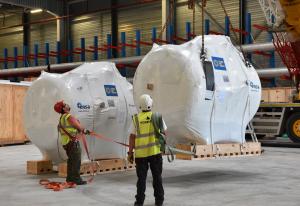Detritiation tanks
Holding the (precious) water
4 Jun 2018
-
Kirsten Haupt
A second batch of tanks for ITER's water detritiation system has been delivered by Europe for installation in the Tritium Building.
Two small holding tanks that are part of the water detritiation system are stored in a warehouse awaiting installation in the Tritium Building.
The new arrivals—two small holding tanks and two feed tanks—were delivered on 30 May and are temporarily stored in a large warehouse on site.
Tritium is a highly valuable resource that will be recovered at ITER in a complex recycling process for re-injection into the plasma. Gases containing low levels of tritium from various locations in the Tokamak Complex—such as the neutral beams cells and the port cells—will undergo a water-based cleansing process in the air detritiation system. The resulting tritiated water will be stored in large holding tanks that arrived at ITER in spring 2015 and became the first processing components to be installed in the Tokamak Complex a year later.
The two newly arrived small holding tanks with a capacity of approximately 7 cubic metres complement the four larger holding tanks. They are designed to hold tritiated water resulting from the maintenance of the water detritiation system.
Two larger feed tanks, 12 cubic metres each, ensure the continuous feeding of tritiated water from all six holding tanks into the water detritiation system. In several steps, electrolyzer units and a catalytic exchange column will treat the tritiated water to recover the valuable tritium fuel for the fusion reaction.
Procured by the European Domestic Agency, the four stainless steel tanks were manufactured in Spain by ENSA with subcontractors ENWESA and Empresarios Agrupados.


